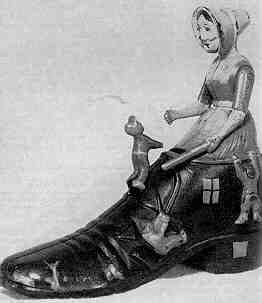Old Woman in the Shoe Bank
by F.H. Griffith - HOBBIES Magazine - March, 1953
 An old favorite nursery rhyme that whisks one back to their childhood is fondly
brought to mind as we list the Old Woman In The Shoe Bank as No. 18 in our numerical
classification. It is quite a rare bank with a more or less unusual background and
certainly has appeal from a subject matter standpoint. There is not a great deal of action
to this bank, however, this is more than compensated for by its other very desirable
features.
An old favorite nursery rhyme that whisks one back to their childhood is fondly
brought to mind as we list the Old Woman In The Shoe Bank as No. 18 in our numerical
classification. It is quite a rare bank with a more or less unusual background and
certainly has appeal from a subject matter standpoint. There is not a great deal of action
to this bank, however, this is more than compensated for by its other very desirable
features.
The bank was designed by William S. Reed of Leominster, Massachusetts. He was granted a design patent June 5, 1883 and a regular patent on November 27, 1883. The original patent papers which the writer is fortunate enough to possess are quite interesting as they picture the bank on wheels with a full figure of the woman at the top of the shoe. The rear wheels were originally intended to move the left arm up and down. It might be well to note that in many cases the banks when actually made were at variance with the patent papers. Of course this is a further interesting phase in the study of the background connected with collecting mechanical banks.
It is pretty well established that Mr. Reed had his banks cast by a foundry located in Fitchburg, Massachusetts. It is not certain that they were made in any large quantity and production was probably on a limited scale.
The writer was fortunate some years ago in talking with Mrs. Reed, who at the time was 82 years old. She told the story of how Mr. Reed originally thought up the Old Woman In The Shoe while in church one Sunday morning. They were apparently a regular churchgoing couple and he was a little reticent and embarrassed about thinking up the plans for the bank while in church.
Mr. Reed also took out a design patent April 8, 1884 for a Puss and Boots Bank but this was apparently never manufactured. So far none have turned up. He is also credited with designing the Little Red Riding Hood Bank. The writer is not certain of this even though it logically follows through with his apparent nursery rhyme theme. There were no patent papers covering this bank in Mrs. Reed’s possession and she made no mention of it at the time of the writer’s visit.
The bank pictured is in exceptionally nice condition and is in the fine collection of Mr. L.C. Hegarty. Naturally this is one of his prides, and deservedly so. It operates as follows: First the lever, located at the back of the shoe just above the heel, is pressed down. This lever, by the way, is in the shape of a child’s foot. As the lever is pressed the woman raises her left arm holding the stick and the boy on the shoe rears back. The coin is placed on the boy’s out-stretched arms and the lever released. The boy drops forward depositing the coin in the bank and the old woman lowers her arm as though swinging the stick at the boy.
The bank is painted in attractive colors. The shoe is black and the children coming out of the shoe in various places are in colors of red, blue and yellow. The old woman is painted in red and yellow apron with natural face and arm coloring. The stick is gold.
The coins are removed by a lock-type coin trap located under the heel of the boot. This trap was missing when the bank was originally found by a used car dealer located in Shrewsbury, Massachusetts. He in turn had found the bank in an old foundry in Fitchburg, Massachusetts, where it had sat on top of a desk in the office for years.
To the best of the writer’s knowledge there are only two of these banks in private collections. One in Mr. Hegarty’s and the other in the extensive large collection of Dr. Arthur E. Corby. It’s a hard bank to find and a rare addition to any collection.
